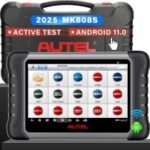Troubleshooting a no-communication issue with a Powertrain Control Module (PCM) through the OBD2 port can be frustrating. If your OBD2 scanner isn’t connecting, it’s likely due to a loss of power or ground to the PCM, or a problem with the communication network itself. This article will walk you through common causes and troubleshooting steps to help you regain communication.
Common Causes of OBD2 Communication Failure with the PCM
Several issues can prevent your OBD2 scanner from communicating with the PCM. Here are some of the most common culprits:
- Fuse #22: A blown fuse can interrupt power to the OBD2 port. Always start by verifying this fuse, checking for voltage on both sides. A reading of ~2.0V instead of the expected ~12V indicates a problem, even if the fuse appears intact.
- Faulty Instrument Cluster: The instrument cluster can cause communication issues on the CAN bus network. Disconnecting it can sometimes isolate the problem.
- Aftermarket Devices: Aftermarket devices like turbo boost controllers (TBCs) can interfere with communication. Disconnecting them is a crucial troubleshooting step.
- PCM Power and Ground: The PCM requires both 12V power and a 5V reference voltage. These are typically supplied directly by the PCM. Check these voltages at the PCM connectors with the relevant components disconnected.
- DLC Power: Pin #16 of the Data Link Connector (DLC), or OBD2 port, should always have 12V power. Verify this voltage.
- PCM Connectors: Corrosion or damage to the PCM connectors can disrupt communication. Disconnecting and inspecting the connectors, especially the center and radiator-side connectors, is recommended.
- Sensor Interference: While less common, faulty sensors like the MAP, MAF, or WIF sensor, or even a failing fuel pump, can sometimes interfere with communication. Disconnecting these sensors can help pinpoint the issue.
- Throttle Position Sensor (TPS): A failing TPS, often associated with the P0121 code, can contribute to rough idle, stalling, and potentially communication problems.
Troubleshooting Steps for No Communication with PCM
If you’re experiencing a no-communication issue, follow these steps:
- Check Fuse #22: Replace if necessary and confirm voltage on both sides.
- Disconnect Aftermarket Devices: Temporarily remove any non-factory components.
- Disconnect Instrument Cluster: Unplug the instrument cluster connectors.
- Verify PCM Power and Ground: Check for 12V and 5V at the PCM connectors.
- Check DLC Power: Ensure Pin #16 of the OBD2 port has 12V.
- Inspect and Disconnect PCM Connectors: Look for damage and try disconnecting them.
- Disconnect Suspect Sensors: Try disconnecting the MAP, MAF, WIF sensor, and fuel pump.
- Consider the TPS: If you’ve experienced P0121 codes, investigate the TPS.
Conclusion
Diagnosing a lack of communication with the PCM can be a process of elimination. By systematically checking these common points of failure, you can increase your chances of identifying the root cause and restoring communication with your OBD2 scanner. If you have checked all of these and still cannot communicate, more advanced diagnostics may be required. A professional automotive technician with access to specialized diagnostic equipment might be necessary to pinpoint the problem.

